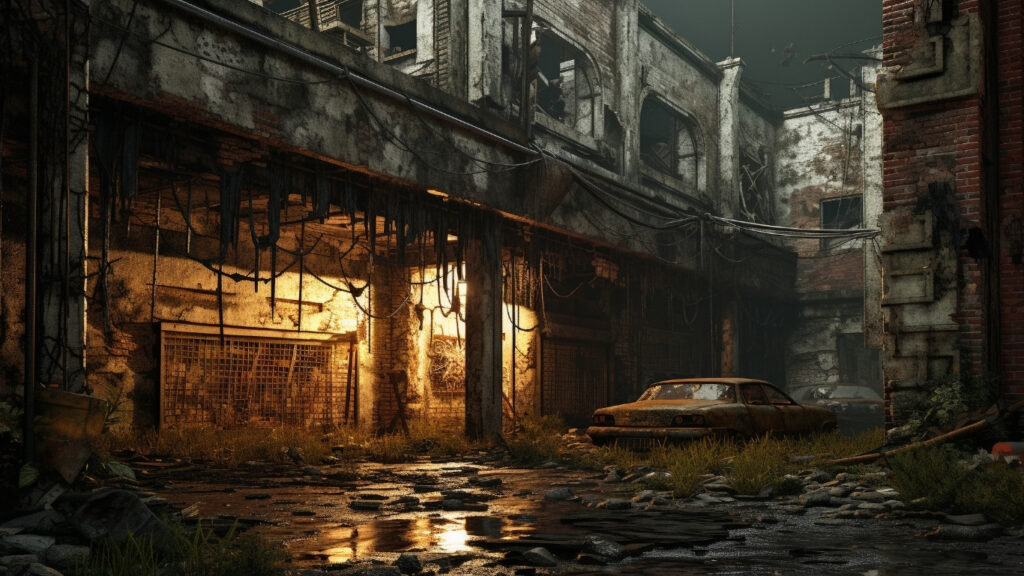🌟 Introduction to Abandoned Neighborhood
Imagine walking down silent streets lined with boarded-up homes. An abandoned neighborhood is both haunting and fascinating.
This article explores why these places exist, the history they hold, and the people who venture in to document their hidden stories.
🏠 What is an Abandoned Neighborhood?
An abandoned neighborhood is a residential area where most or all homes are deserted.
Unlike a single abandoned house, entire blocks sit empty—windows shattered, nature reclaiming sidewalks.
Key characteristics include:
- Vacant or decaying buildings
- Overgrown vegetation
- Graffiti and vandalism
- Lack of public services
Such places often become symbols of urban decay, reflecting deeper social, economic, or environmental issues.
🔎 Why Do Neighborhoods Become Abandoned?
Abandonment rarely happens overnight. It’s usually the result of multiple, interconnected factors:
📉 1. Economic Decline: Abandoned Neighborhood
- Loss of local industry or major employers
- Falling property values
- Outmigration in search of jobs
Example: The collapse of Detroit’s auto industry left entire neighborhoods empty.
🌪️ 2. Natural Disasters: Abandoned Neighborhood
- Hurricanes, floods, earthquakes
- Cost of rebuilding too high
Example: New Orleans’ Lower Ninth Ward after Hurricane Katrina.
⚖️ 3. Environmental Contamination:
- Toxic waste sites
- Unsafe water or soil
Example: Love Canal in New York—residents evacuated due to chemical dumping.
🏛️ 4. Policy and Planning Failures:
- Redlining and disinvestment
- Poor urban planning
- Lack of affordable housing initiatives
⚔️ 5. Conflict or Crime:
- War zones and civil unrest
- High crime driving residents away
🌍 Real-World Examples of Abandoned Neighborhoods
Let’s look at famous cases that highlight these issues:
📌 Detroit, Michigan
- Once booming, now filled with abandoned homes.
- Population declined from 1.8 million (1950) to under 700,000.
- Urban explorers flock to photograph its ruins.
📌 Oradour-sur-Glane, France
- Preserved as a memorial after Nazi troops massacred residents in WWII.
- An eerie “frozen in time” village.
📌 Hashima Island, Japan (Gunkanjima)
- Abandoned mining settlement.
- Ghostly apartment blocks battered by sea winds.
These examples attract urban explorers, historians, and tourists eager to understand lost histories.
🧭 The Appeal of Urban Exploration
Why do people visit abandoned neighborhoods?
Motivations include:
- Documenting history before it’s gone
- Photography of decaying beauty (“ruin porn”)
- Adventure and curiosity
Many explorers share their findings on YouTube or Instagram, building awareness of forgotten places.
Expert Insight:
Architectural historian Brian Dillon argues these explorations remind us of society’s failures—and possibilities for renewal.
⚠️ Dangers and Ethical Considerations
Before you think about exploring one yourself:
⚠️ Hazards:
- Unstable structures
- Asbestos and mold
- Crime or trespassing charges
✔ Ethical questions:
- Respect private property
- Don’t vandalize or loot
- Share stories responsibly
Urban explorers emphasize “take only photos, leave only footprints.”
🔨 Revitalization and Redevelopment Efforts
Not all abandoned neighborhoods stay empty forever.
Successful revitalizations often include:
- Government investment
- Community-led initiatives
- Historic preservation grants
Case Study:
Pilsen in Chicago transformed from blight to a vibrant, art-filled community through local activism.
Key strategies:
- Affordable housing policies
- Small business support
- Environmental remediation
These efforts show hope exists—even in places once written off.
✅ Conclusion: Abandoned Neighborhood
An abandoned neighborhood is more than just crumbling buildings.
It’s a testament to human stories—of prosperity, neglect, and sometimes rebirth.
If these places teach us anything, it’s the importance of thoughtful urban planning and community resilience.
👉 Want more stories of lost places and urban renewal? Subscribe to our newsletter and join the conversation!
🙋 FAQs about Abandoned Neighborhood
q. What is considered an abandoned neighborhood?
A. A residential area where most or all homes are unoccupied, often marked by decay and lack of services.
q. Why do neighborhoods become abandoned?
A. Reasons include economic decline, natural disasters, environmental contamination, poor urban planning, and conflict.
q. Is it legal to explore abandoned neighborhoods?
A. Often it’s trespassing unless you have permission. Always research local laws and respect private property.
q. Can abandoned neighborhoods be restored?
A. Yes! Through investment, policy changes, and community action, many places have seen successful revitalization.






